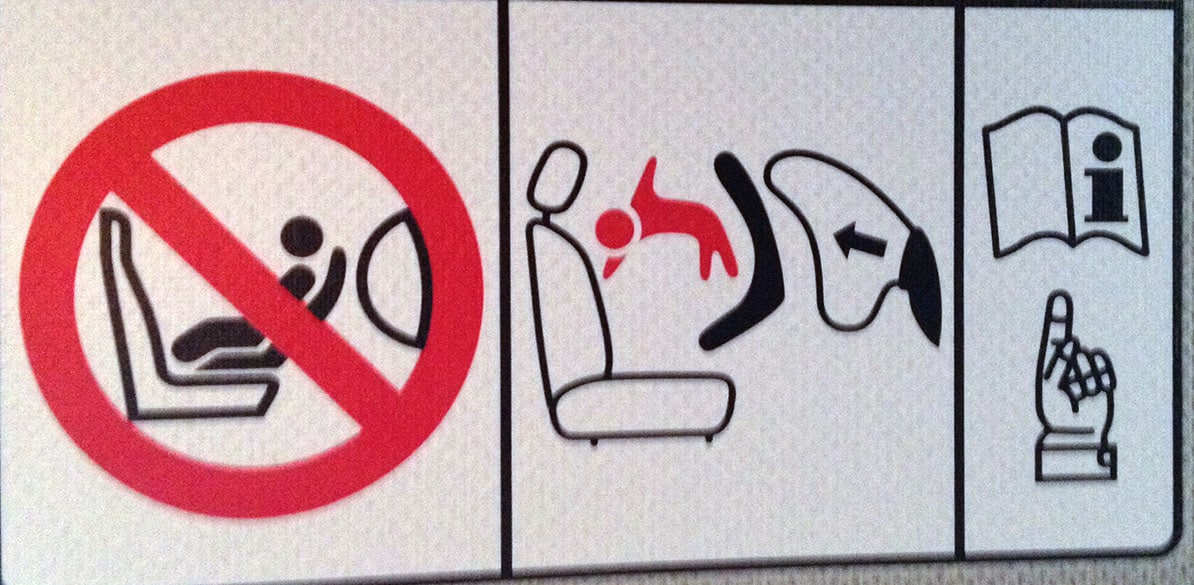You should sit at least 10 inches away from an airbag to ensure safety. Airbags in cars are a vital safety feature designed to protect passengers during a collision.
However, if you are positioned too close, the force that deploys the airbag can cause serious injury. On the other hand, sitting too far away can reduce the airbag’s effectiveness. Therefore, finding the right distance between yourself and the airbag is crucial for optimal protection.
This article will provide important information on how far away you should sit from an airbag in order to maximize safety and reduce the risk of injury during an accident.

Importance Of Correct Airbag Distance
When it comes to driving safety, one of the most critical factors to consider is the distance at which you sit from the airbag. The airbag is designed to deploy rapidly in the event of a crash, providing a cushion of protection between you and the steering wheel or dashboard. However, sitting too close or too far from the airbag can compromise its effectiveness and put you at greater risk of injury. In this section, we will explore the recommended distance for sitting from an airbag, as well as the potential effects of sitting too close or too far.
Recommended Distance
The National Highway Traffic Safety Administration (NHTSA) recommends that drivers and front passengers sit at least 10 inches away from the airbag. This distance is measured from the center of the steering wheel or dashboard to the sternum (the central bone in the chest). By maintaining this recommended distance, you allow the airbag to deploy properly and minimize the risk of injury.
Effects Of Sitting Too Close

Sitting too close to the airbag can have serious consequences. If you are positioned less than 10 inches away, the force of the airbag’s deployment can cause significant injuries. These injuries may include broken bones, facial lacerations, bruising, or even internal damage. It’s important to remember that airbags deploy at a high velocity, and being too close can subject you to excessive impact forces.
To avoid these risks, make sure to adjust your seat so that you are at least 10 inches away from the airbag. Additionally, pregnant women should take extra precautions and consult with their healthcare providers to determine the safest seating distance.
Effects Of Sitting Too Far
While it may seem logical to sit as far away from the airbag as possible, sitting too far can also be dangerous. Maintaining a seating distance of more than 10 inches from the airbag can diminish its effectiveness. In the event of a crash, the airbag may not fully protect you if you are positioned too far away.
To ensure optimal protection, position yourself within the recommended distance from the airbag. Remember that the airbag is a crucial safety feature designed to work in conjunction with your seatbelt to minimize the risk of injury during an accident.
In conclusion, maintaining the correct distance from the airbag is paramount for your safety on the road. Sitting neither too close nor too far ensures that the airbag can deploy effectively and protect you in the event of a crash. By following the recommended distance guidelines, you can maximize your chances of staying safe behind the wheel.
Determining The Correct Distance
Determining the correct distance to sit from an airbag is crucial for your safety. Follow manufacturer recommendations and ensure that you are at least 10 inches away to minimize the risk of injury during deployment.
Safety Guidelines
When it comes to airbag safety, determining the correct distance plays a crucial role in protecting yourself and your passengers in the event of a car accident. It is essential to adhere to the safety guidelines recommended by experts to maximize the effectiveness of airbags and minimize potential injuries.
Driver Versus Passenger Seat
The distance you should sit from the airbag can vary depending on whether you are sitting in the driver’s seat or the passenger seat. In general, for both seats, it is recommended to position yourself at least 10 inches away from the airbag module, which is typically located in the steering wheel for the driver and in the dashboard for the passenger.
- Driver seat: Ensure that your chest is at least 10 inches away from the steering wheel, allowing ample space for the airbag to deploy without causing excessive impact injuries.
- Passenger seat: Just like the driver seat, maintain a distance of at least 10 inches from the dashboard to provide sufficient space for the airbag to inflate and protect you effectively.
Adjusting Seat Position
To ensure you are at the correct distance from the airbag, it is essential to properly adjust your seat position. Follow these steps:
- Start by making sure your seat is in an upright position, allowing you to sit comfortably and maintain good visibility.
- Adjust the seat’s distance from the steering wheel or dashboard by moving it forward or backward until you have at least 10 inches of space between your chest and the airbag module.
- Securely fasten your seatbelt, ensuring it is positioned correctly across your lap and shoulder.
- Double-check your seat adjustments and confirm that you are sitting at the recommended distance. Remember to check this every time you enter the vehicle to ensure consistent safety.
By following these simple guidelines and adjusting your seat position accordingly, you can protect yourself and your loved ones from potential airbag-related injuries, allowing the airbag to deploy effectively and provide the intended safety benefits.
Factors To Consider

When it comes to airbag safety, one of the crucial aspects is determining the appropriate distance to sit from an airbag in your vehicle. Several factors play a significant role in this decision, including the type of vehicle, your height and size, and your seating position. By considering these factors, you can ensure optimal safety in the event of an airbag deployment.
Vehicle Type
The type of vehicle you drive has a direct impact on how far you should sit from the airbag. It is essential to note that different vehicle types have different airbag systems, placement, and deployment speeds. Here’s a breakdown based on common vehicle types:
| Vehicle Type | Recommended Distance from Airbag |
|---|---|
| Sedans and Hatchbacks | 10-12 inches |
| SUVs and Crossovers | 12-16 inches |
| Trucks and Vans | 16-24 inches |
Height And Size
Your height and size also play a crucial role in determining the appropriate distance to sit from an airbag. Generally, taller individuals may need to sit further back to ensure their heads are not too close to the airbag module during deployment. Here are some guidelines to consider:
- If you are shorter in height, aim for 10-12 inches between your chest and the airbag module.
- If you are taller, consider increasing the distance to 12-16 inches.
- Your weight also matters; larger individuals may need to adjust their seating position accordingly.
Seating Position
Another factor to consider is your seating position within the vehicle. Different seating positions have varying levels of airbag deployment impact. Here’s what you should bear in mind:
- For the driver’s seat, maintain an appropriate distance while ensuring you can reach the pedals comfortably.
- If you are seated in the front passenger seat, ensure you are not too close to the dashboard or airbag module.
- Rear passengers should avoid sitting too close to side airbags or in positions where they may obstruct curtain airbag deployment.
- Always follow the vehicle manufacturer’s guidelines for proper seating position and adjust your seat accordingly.
By considering these critical factors, you can find the ideal distance to sit from an airbag, maximizing your safety in case of an accident. Remember, it’s crucial to take into account your vehicle type, height and size, and seating position to ensure optimal airbag protection.
Common Myths Debunked
There are numerous myths and misconceptions surrounding airbags, causing confusion and misinformation among car owners. In this section, we will debunk some of the most common myths associated with airbags to provide you with accurate and essential information for your safety. Read on to learn the truth about how far away you should sit from an airbag.
Airbags Causing Injuries
One of the prevalent myths about airbags is that they can cause more harm than good in an accident. While it is true that airbags can cause injuries, these instances are exceedingly rare and typically occur when certain guidelines are not followed. The purpose of an airbag is to provide an additional layer of protection in the event of a collision, and when used correctly, they can save lives. When deployed, airbags take only milliseconds to inflate and cushion the impact, reducing the likelihood of severe injuries.
It is crucial to understand that airbags are supplemental restraint systems designed to work in conjunction with seat belts. Both safety components are indispensable, and using them properly significantly decreases the risk of injuries. While airbags may have caused injuries in isolated cases, the benefits far outweigh the risks.
Optimal Distance For Children
Another common myth surrounding airbags is that they pose a danger to children when they are seated in the front passenger seat. It is important to note that children should always sit in the backseat, especially if they are under a certain age or height according to local regulations. Children are at a higher risk of injury due to the forceful deployment of airbags, as these safety devices are designed to protect adults.
Placing children in the backseat, using properly installed child safety seats or booster seats, reduces the risk of injury. Remember to follow the instructions provided by the car seat manufacturer and local laws to ensure proper installation. By adhering to these guidelines, you can minimize the potential risks that airbags may pose to children in the event of an accident.
Airbag Deactivation
Some individuals believe that deactivating airbags altogether is a safer option. However, this is a misconception that can have severe consequences. Airbag deactivation should only be considered in specific circumstances, such as when a child must be placed in the front seat due to a medical condition or when the rear-facing child seat must be installed in the front passenger seat due to lack of space in the backseat.
It is essential to consult with a certified mechanic or your vehicle manufacturer before deactivating airbags, as doing so without proper guidance can compromise your safety. Keep in mind that airbags are an integral part of the overall safety system, and their benefits should not be overlooked without professional advice.
In conclusion, airbags are effective safety features that play a crucial role in protecting occupants during collisions. By understanding and dispelling these common myths associated with airbags, you can better ensure your safety and the safety of your passengers.
Advanced Safety Technologies
Modern vehicles are equipped with advanced safety technologies that work in conjunction with airbags to provide optimal protection to occupants. These technologies are designed to improve the effectiveness of airbags in the event of a collision, ensuring maximum safety for drivers and passengers alike. In this section, we will take a closer look at three key technologies: adaptive airbags, seat belt pre-tensioners, and occupant sensing systems.
Adaptive Airbags
Adaptive airbags represent a significant advancement in vehicle safety technology. Unlike traditional airbags, which deploy with a standard force regardless of the occupant’s size, adaptive airbags adjust their deployment force based on the individual’s weight, size, and position. By using advanced sensors and data analysis, adaptive airbags can tailor the level of protection provided, reducing the risk of injury.
By adapting to the specific circumstances of each occupant, these airbags minimize the potential for excessive force deployment, which could cause more harm than good. They ensure that in the event of a collision, the airbag inflates to an appropriate level to cushion the impact and protect the occupant without causing unnecessary injuries.
Seat Belt Pre-tensioners
Seat belt pre-tensioners are another crucial safety feature found in modern vehicles. These devices work in conjunction with airbags to maximize occupant protection during a collision. Seat belt pre-tensioners use pyrotechnic devices or motors to tighten the seat belt across the occupant’s body in the event of a collision.
By removing any slack in the seat belt, pre-tensioners ensure that the occupant remains securely restrained, minimizing the risk of forward movement during impact. This not only helps prevent injuries but also allows the airbag to provide the most effective protection by keeping the occupant in the optimal position.
Occupant Sensing Systems
Occupant sensing systems are advanced technological solutions designed to ensure the proper deployment of airbags based on the presence and characteristics of occupants. These systems use sensors to detect the position, weight, and size of each occupant in the vehicle.
By analyzing this data, the system determines whether to deploy the airbags and adjust their deployment force accordingly. For example, if no one is seated in a particular passenger seat, the system may deactivate the airbag to prevent unnecessary deployment. This intelligence helps optimize occupant protection while minimizing the potential for injury caused by airbag deployment.
Frequently Asked Questions
How Far Away Should You Sit From An Airbag?
For optimal safety, it is recommended to sit at least 10 inches away from the airbag in your car.
Can Sitting Too Close To An Airbag Be Dangerous?
Yes, sitting too close to the airbag can increase the risk of injury during a collision. Maintain a safe distance while driving.
What Happens If You Sit Too Far From An Airbag?
If you sit too far from the airbag, it may not be able to provide adequate protection in case of an accident. Maintain a reasonable distance.
Is It Safe To Have Children Sit In The Front Seat Near An Airbag?
It is safest for children to sit in the back seat. If they are seated in the front, make sure to disable the passenger-side airbag to avoid injury.
Conclusion
Safety is paramount when it comes to airbags in vehicles. Ensuring you are seated at an optimal distance from the airbag is key to minimizing the risk of injury. By maintaining a distance of at least 10 inches from the airbag, you can protect yourself from potential harm while still allowing the airbag to deploy effectively.
Remember, safety first!
Learn more: Do Semi Trucks Have Airbags?